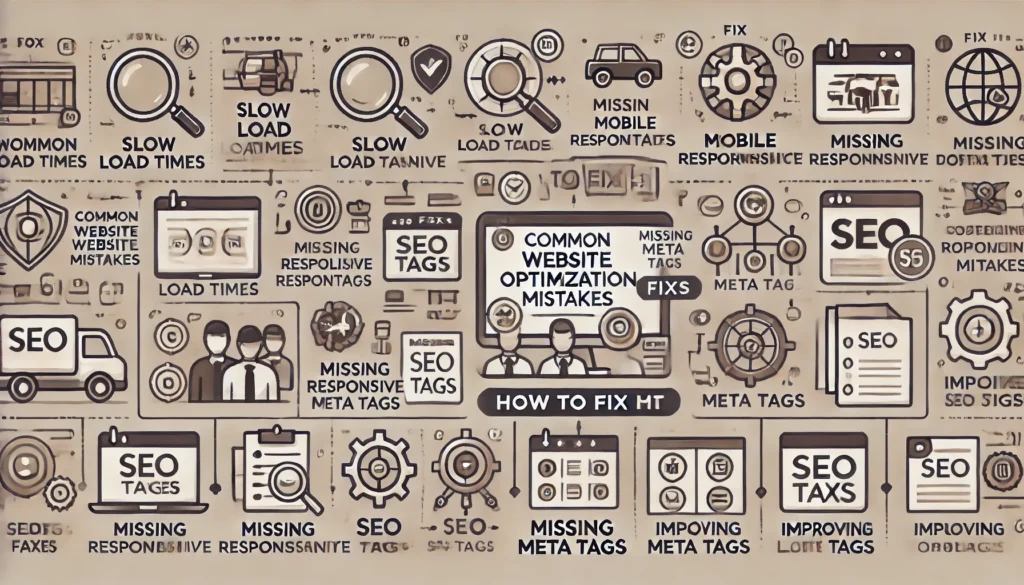Boost Your Online Presence: The Importance of Website Optimization for Small Businesses
Imagine doubling your website traffic and bringing in more customers, all without spending a fortune on ads. The key? Website optimization. Small businesses that focus on SEO strategy, responsive design, and engaging content can dramatically improve their search results rankings and user engagement.
Yet, many small business owners overlook key optimization factors like usability testing, mobile responsiveness, and page speed. The result? A poor user experience that drives away potential customers before they even have a chance to engage with your brand.
This is your beginner’s guide to search engine optimization and website improvement. By the end, you’ll know how to optimize your site for Google Search, attract new customers, and ensure a positive experience for every visitor.
Why Website Optimization Matters for Small Businesses

For small businesses, website optimization isn’t just a technical upgrade; it’s a business necessity. Studies show that 47% of users expect a webpage to load in two seconds or less. If your site is slow or difficult to navigate, potential customers will leave and turn to competitors.
Beyond speed, Google Search rewards optimized websites with higher rankings in search results. Businesses that focus on SEO strategy, mobile responsiveness, and relevant content gain more visibility and higher conversion rates.
Still not convinced? Consider this: 88% of users won’t return to a website after a bad experience. Optimizing your site improves user engagement, making it user-friendly and accessible across different devices. In short, a well-optimized website means more customers, better rankings, and increased revenue.
Essential SEO Elements for Small Business Websites
To rank higher on Google Search, small businesses need to focus on key SEO elements that improve search results visibility and enhance user experience. Here’s what you need to prioritize:
1. Keyword Optimization
- Use relevant keywords in page titles, headings, and content while avoiding duplicate content.
- Tools like Google Search Console and Google Analytics help identify what your target audience is searching for.
2. On-Page SEO
- Optimize meta descriptions, headings, and internal links to make your content easier for search engines to understand.
3. Technical SEO
- Improve mobile responsiveness, page load speed, and site structure.
- Sites that load quickly rank higher and provide a better user experience.
4. Local SEO (For Brick-and-Mortar Businesses)
- If you run a physical business, setting up Google My Business and collecting customer testimonials can improve online visibility and attract new customers.
SEO isn’t just about search rankings; it’s about creating an engaging, user-friendly website that converts visitors into loyal customers.
Mobile Responsiveness & User Experience

In today’s digital world, mobile responsiveness is non-negotiable. More than 60% of searches happen on mobile devices, and Google prioritizes mobile-friendly websites in search rankings. If your site isn’t optimized for different screen sizes, you are losing out on potential customers.
How to Improve Mobile Responsiveness
- Use responsive design to ensure your site adapts to different devices for a smooth experience.
- Test with Google Search Console using the Mobile-Friendly Test to find and fix usability issues.
- Improve page speed by compressing images, enabling caching, and reducing unnecessary scripts so pages load quickly. Use Google PageSpeed Insights to analyze performance.
- Simplify navigation to ensure buttons, text, and menus are easy to tap on small screens.
A mobile-friendly website is not just about SEO; it is about providing a positive experience that keeps users engaged and drives more customers to your business.
The Role of Google Analytics & Search Console
Tracking and Improving Performance
Small businesses often struggle to measure their SEO success. This is where Google Analytics and Google Search Console come in. These tools provide valuable data to help optimize your website for better search results.
Key SEO Metrics to Monitor
- Website traffic – Find out how visitors arrive at your site, whether through organic search, social media, or direct visits. Set up Google Analytics here.
- User engagement – Analyze bounce rates, session duration, and interaction levels to assess site performance. Learn more about engagement metrics.
- Search Console insights – Identify which keywords bring in the most traffic and fix duplicate content or indexing errors. Set up Google Search Console.
- Page load speed – If your site does not load quickly, visitors will leave before engaging with your content. Use Google PageSpeed Insights to analyze and optimize speed.
By leveraging these SEO tools, small businesses can make data-driven decisions to improve their site’s performance and attract more customers.
How to Create Engaging Content for SEO
Creating engaging content is one of the most effective ways to improve search engine optimization (SEO) and increase website traffic. High-quality, relevant content keeps visitors on your site longer, signals value to search engines, and encourages user engagement.
Best Practices for SEO-Friendly Content
- Write for your target audience, not just for search engines. Use natural language and provide valuable insights that answer common questions. Google’s Search Central guide on helpful content explains this further.
- Optimize for keywords without keyword stuffing. Use Google Search Console to find search terms your audience is using, and integrate them naturally into your page content.
- Use headers and formatting to improve readability. Break up large blocks of text with H2 and H3 subheadings, bullet points, and short paragraphs.
- Add internal and external links. Link to other pages on your site to keep users engaged, and cite authoritative sources to boost credibility. Moz’s guides explains its impact on SEO.
- Incorporate multimedia elements. Images, videos, and infographics improve user experience and increase time spent on your website. Use Google PageSpeed Insights to ensure media files do not slow down your site.
Well-optimized content helps small businesses improve their search rankings, user engagement, and conversion rates, all of which are essential for online visibility.
Common Website Optimization Mistakes & How to Fix Them

Many small businesses struggle with SEO mistakes that hurt search rankings and user experience. Avoiding these common pitfalls can make a significant difference in your site’s performance and conversion rates.
Top Website Optimization Mistakes and Fixes
- Ignoring mobile responsiveness: If your site is not mobile-friendly, it will rank lower in Google Search results. Fix this by using responsive design and testing your site with Google Search Console’s Mobile-Friendly Test (Test here).
- Slow page speed: A site that does not load quickly leads to high bounce rates. Use Google PageSpeed Insights (Check speed) to analyze and improve performance.
- Neglecting Google Analytics and Search Console: Without tracking performance, it is difficult to make improvements. Set up Google Analytics (Get started) and Google Search Console (Setup guide).
- Using duplicate content: Search engines penalize websites that copy text from other websites. Use Copyscape (Check content) to ensure originality.
- Lack of internal linking: Connecting related pages improves navigation and SEO.
By fixing these website optimization mistakes, small businesses can improve their Google Search rankings, user engagement, and customer conversions.
Take Control of Your Online Success
In today’s digital world, a well-optimized website is the key to standing out, attracting new customers, and staying ahead of the competition. By focusing on mobile responsiveness, SEO strategy, engaging content, and performance tracking, small businesses can turn their websites into powerful growth engines.
Every second your site takes to load, every missed SEO opportunity, and every poor user experience could mean lost business. But the good news? You have the power to change that.
Start optimizing today by running a website audit, enhancing your SEO strategy, and leveraging tools like Google Analytics and Search Console to stay ahead.
Ready to take your online presence to the next level? Visit Dashboard Co-Op for expert insights, powerful resources, and the support you need to thrive in the digital landscape.